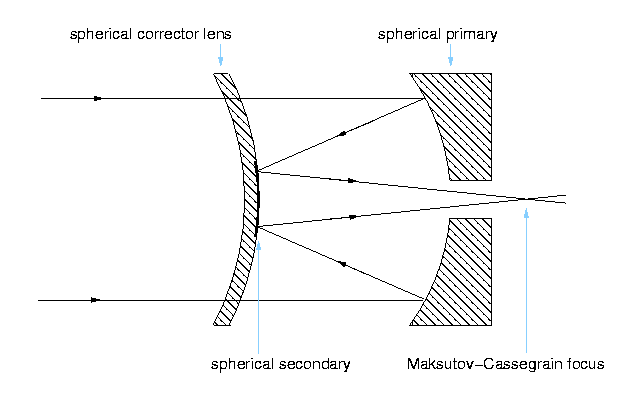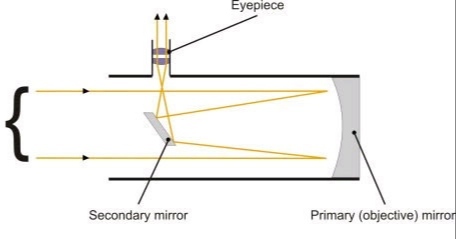*This post may contain affiliate links. This means we may make a commission if you purchase an item using one of our links*
The main differences between Maksutov-cassegrain (Maks) and reflector telescopes are that reflector telescope only use mirrors, either spherical or parabolic whereas Maks use a combination of a spherical mirror and a glass based corrector lens. As a result of their designs, Maks require light to bounce twice inside the tube making them great for planetary viewing whilst reflectors are generally better and clearer for wide field views of space.
There are other differences and the the odd few similarities between these two lens types so, continue reading if you want a more thorough breakdown of how these optics work.
What Is A Maksutov-Cassegrain Telescope?
Table of Contents

The Mak design falls under a compound based system meaning it uses both a lens and a mirror. Maks have a more reflector based design but use corrector lenses to eliminate any kind of aberration that would normally occur due to a pure mirror design.
When light enters a Mak telescope, it will pass through a corrector lens (known as a meniscus corrector) found at the front of the telescope, hit the concaved primary mirror, reflect onto a smaller convex secondary mirror, pass through the hole in the middle of the primary mirror and into an eyepiece (or camera).
This means that the reflected light will be folded in Maks resulting in a focal length much longer than what a refractor or a reflector telescope of the same size would produce.
In general Maks tend to produce focal lengths 5 – 7 times larger than other telescopes at the same size and dimensions. This is mostly due to the convex design of the secondary mirror which is found right at the front of the tube.
Simply put, the convex secondary lens manages to magnify the focal length so instead of being only 2 times longer due to the light is folded once in the process, the lens magnifies the length multiple times over.
The extreme focal length in turn allows for Maks to be really good telescopes for viewing planets as narrower images are better for viewing more detail on singular entities like Jupiter or Saturn.
What Is A Reflector Telescope?

Reflector optics utilize mirrors to produce visuals for telescopes. These mirrors are regarded as primary and secondary mirrors. The primary is concave mirror whilst the secondary mirror is flat with its main purpose being to reflect the gathered light into an eyepiece.
As for how a reflector telescope works, light is often gathered in through the open end of the tube near the top of the device hitting the concave mirror at the base before reflecting onto the secondary mirror and then into your eye.
These devices can come in multiple different variations but the most common ones utilized are Newtonian reflector and spherical reflector optics, with the latter generally the more affordable option.
The main difference between a spherical and Newtonian is that a Newtonian reflector uses a parabolic primary mirror which allows for light to focus at a singular point unlike latter that uses a spherical primary mirror which produce blurry and unfocused visuals.
As a result Newtonian reflectors are definitely the superior reflective telescope. Reflective optics are known to be the best for viewing faint deep space objects and also produce more color accuracy than glass based telescopes (aka refractors).
One of the negatives of these optics is that the OTA tube will be open, meaning far more maintenance will be required to keep the visuals at a high level as the mirrors will get dusty and they’re also easier to knock out of alignment due to this design.
Nevertheless, reflectors provide the best aperture per dollar ratio on the market which is why they’re very popular among most amateur astronomers and veterans who want the largest Aperture for a relatively affordable price.
How Are Maksutov-Cassegrain And Reflector Telescopes Similar?
Although the similar features aren’t too vast between these two, maksutov-cassegrains and reflectors do share a few common features
These include the fact that both can see a lot of celestial objects in space despite their different optical designs and both also use mirrors.
Differences Between Maksutov-Cassegrain And Reflector Telescopes
In regards to the differences between the two, they include the following:
- Reflectors use only mirrors within the tube whilst Maks use both a spherical mirror and corrector lens inside.
- Reflectors are generally the cheaper of the two when starting out.
- Maks tend to use a closed tube design meaning they will require less maintenance than your average reflector that has an open tube design.
- Maks are better for planetary viewing due to their longer focal lengths on average.
- Inversely the highest quality reflectors will produce more detail for more expansive viewings of stars in the night sky.
- Reflectors have no boundaries in regards to how large they can get whereas Maks would require significantly more resources to produce optics the size of the Hubble telescope or the James Webb telescope for example.
- Maks are more likely to overheat due to their enclosed tube design.
- Maks are better with GoTo mounts.
Summary
Maksutov-Cassegrain telescopes are better suited for those who want the additional function of a GoTo mount and don’t want to take up too much space when storing it, whereas reflectors will typically be the most cost efficient per aperture devices out there but are also more bulky.
Both have their pros and cons, where Maks are probably better for those more experienced and willing to spend more money viewing stars whereas a reflector is the best entry point for new buddying astronomers who not only can pick up on the best practices for looking after these devices but, will also allow them to see awe-inspiring visuals of outer space.

